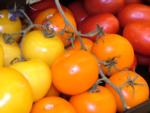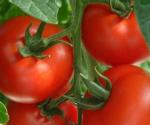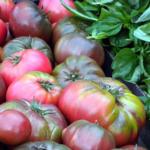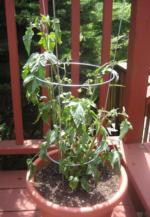Tomatoes, growing
-
Growing tomatoes can be rewarding and challenging. Each year seems to bring something new. But there is almost nothing that tastes better than a fresh, delicious tomato from your own garden. Here's a general article with advice for Growing Tomatoes in the Home Garden.
Varieties
There are many varieties to choose from, but the best tomato is the one that grows well in your garden and tastes good to you. It’s also best to choose disease-resistant varieties. Look for disease resistance indication on seed packets or nursery tags. If information is not on the tag, ask the nurseryman. The initials stand for disease/pest resistance against the following common diseases and pests: V=verticillium wilt (fungus), F and FF=fusarium wilt (fungus), A-early blight (fungus), N=nematodes (microscopic roundworms), T=tobacco mosaic virusCherry tomatoes have small and abundant fruit. They are available in red and yellow, and often used in salads. Some varieties are small compact plants, and some can grow up to 6 or 7 feet tall.
Container types are generally compact and determinate (bushy plants that grow to a certain height, set fruit all at once, then decline).
Standard types can be determinate or indeterminate (vine-like growth and fruit set throughout the season). Fruit is of different sizes, depending on variety.
Heirloom tomatoes are increasingly popular. The scientific definition of an heirloom tomato is an open-pollinated variety; that is, the flower is pollinated with pollen from another plant to make a fruit with seeds that can reproduce the tomato, true to type. Growers can save seed from their crop and sow again in following years and the plants will produce fruit with the same characteristics and quality of the parent. The seeds can be passed down so they become ‘heirlooms’.
They appear in all shapes, sizes, colors and flavors and offer opportunities to explore growing new and interesting varieties.
Click here for a list of tomato varieties (Table 1, page 3) that includes the recommended growing zone, disease-resistance, vine habit and plant size, color and size of fruit, and time to maturity.
How to Grow
Here are the basic things that tomatoes need to grow.
Sun – 6 hours at least, daily. Tomatoes love heat. They will fail to set fruit when temperatures at night are below 55°F degrees, or when daytime temperatures are over 100°F.
Soil – Will grow in most soils as long as there is good drainage. Unless you have perfect loamy soil, amend soil with compost.
Water – Regular watering to maintain uniform soil moisture; overwatering results in tasteless fruit; irregular watering can result in leaf roll, blossom end rot, and cracked fruit. For more intense taste, do not water 24-48 hrs before picking. Avoid wetting foliage as this promotes disease. Tomatoes are deep rooted so water deeply.
Mulch – Apply a mulch to help maintain uniform soil moisture and prevent weeds.
Fertilizer – Mix organic fertilizer, according to package directions, in planting hole when planting. No need to fertilize again until blossoms appear, then fertilize lightly if desired every 2-4 weeks until the end of harvest.
Space appropriately – Good air circulation will inhibit disease. Follow spacing on seed packet or nursery tags - generally 1½ to 3 feet apart for staked plants.
Support – Stake tomatoes the day you plant them. Use a 6 ft. stake, sturdy tomato cages, concrete reinforcing screen, spiral stakes, post and string method, a trellis or a decorative obelisk.
Crop rotation - Do not plant in same spot in the garden year after year; rotate to a new location that has not been planted with tomatoes or tomato relatives every 2 years. Tomato relatives include peppers, eggplant, white potatoes. For container planting, clean pots thoroughly before use and use new potting soil every year.
When to Plant
You can start tomatoes from seed or grow from transplants. Seed can be sown indoors 6 to 8 weeks before the last frost date in your area. In coastal Southern California, the last frost date is usually predicted to be March 1st. Transplants can be set into the ground beginning in about April, but tomatoes are warm weather plants, so planting when the weather is warmer is usually better. Read more about planting dates for tomatoes.Types of Tomatoes
Tomatoes are described as being one of two types when referring to their growth habit.
Determinate – these tomatoes grow like a bush to a certain height (usually 3 to 5 feet), set all fruit at the same time, and then decline. Most early-ripening tomatoes are determinate types.
Indeterminate – these tomatoes have a vine-like growth which continues throughout the season. They also continue to set fruit during the entire season. Many standard-sized, large-fruited tomatoes typically grown in home gardens are indeterminate types.
Check the tag on the plant or the seed packet to find out which kind of tomato plant you have.
Growing Tomatoes in Containers
Tomatoes can be very happy planted in a container. It's important to follow a few simple guidelines.
Size of Container - Choose a container big enough to “hug” – 16 inches wide or more is best (15 gallon), although determinate varieties will do fine in a 5 gallon container. Make sure the container is clean.
Soil - Fill the container with good quality potting soil and plant the tomato transplant deep into the soil. Add organic fertilizer according to package instructions.
Variety - Choose a patio or bush variety for best results. Check the list of tomato varieties (Table 1, page 3) to find the one with an appropriate plant size and fruit size.
Water regularly, as pots will dry out faster than in-ground plantings. Keep soil evenly moist but not soggy.
Use support - even bush types should have a small tomato cage or other support system. Put in the support at the same time that you plant the tomato in the pot.
Fertilize with low nitrogen fertilizer every 2-4 weeks after blossoms appear.
Tomatoes can be planted in hanging baskets, but choose a variety with smaller fruit.
Growing Tomatoes in the cool season
Most tomatoes are considered warm season crops and need summer temperatures in order to survive and produce. Almost all gardens have microclimates that are different from the norm and may allow continuation at least for a while to grow tomato plants. Container plants, in this instance, would most likely have the greatest probability for success since their environment can be better controlled than an in-ground plant.
For best results these plants need about 6 to 8 hours of sunlight, so look first for an area that gets the most sunlight. If that area is also protected or near a south wall it may also be warm enough. If the space is more in an open area, consider using a covering. In the colder parts of the county many home gardeners use a cloth covering (plant protector) to warm the area so they can start crops earlier in the spring. These can usually be purchased from gardening catalogs or at nurseries. Be prepared to cover or move the plants to a protected area if there is frost predicted.
There are a number of tomato plants that are considered cool season and can be planted in early fall to produce tomatoes throughout December and beyond depending on the weather. They have names like Siberian or Glacier. They can be found in the fall season at local nurseries. If the plants are already up and growing, just continue to enjoy them and let nature take its course. For more information about tomatoes, go to the UCCE Vegetable Resource and Information Center.




